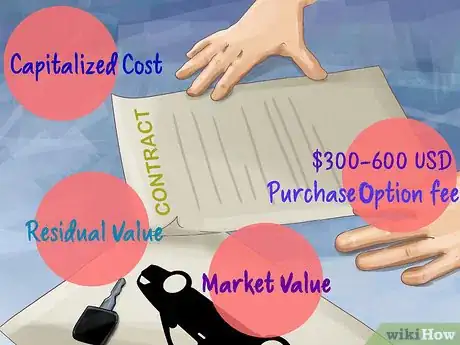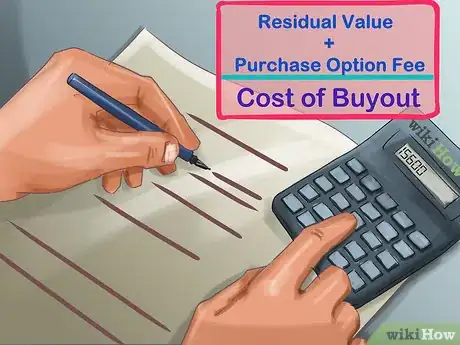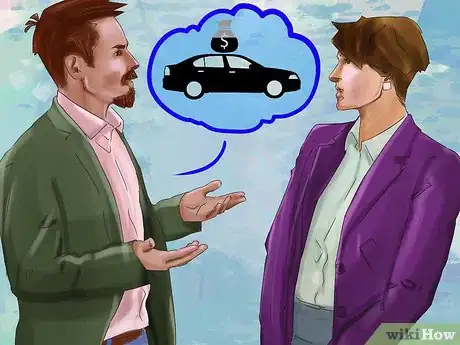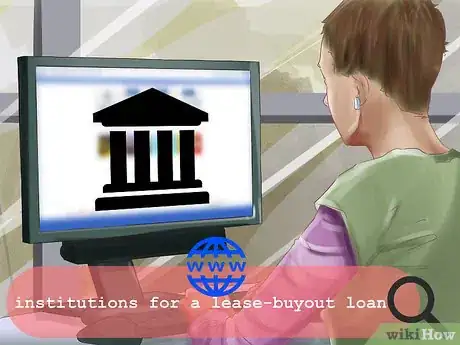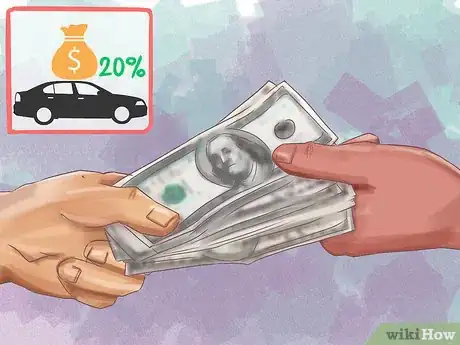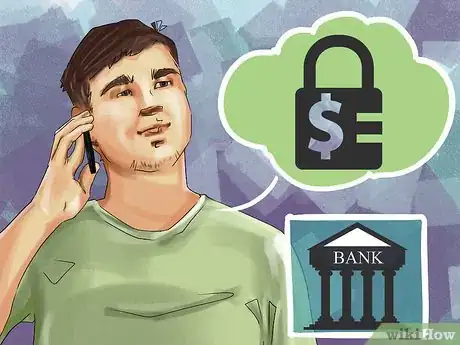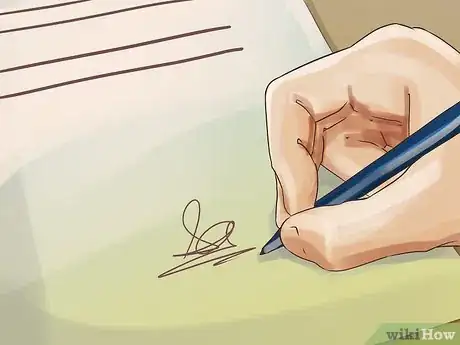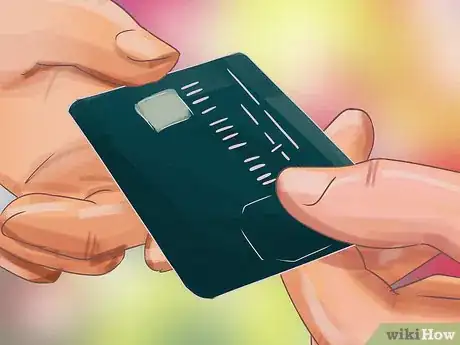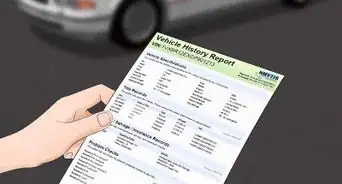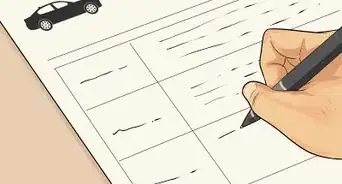This article was co-authored by Hovanes Margarian. Hovanes Margarian is the Founder and the Lead Attorney at The Margarian Law Firm, a boutique automotive litigation law firm in Los Angeles, California. Hovanes specializes in automobile dealer fraud, automobile defects (aka Lemon Law), and consumer class action cases. He holds a BS in Biology from the University of Southern California (USC). Hovanes obtained his Juris Doctor degree from the USC Gould School of Law, where he concentrated his studies in business and corporate law, real estate law, property law, and California civil procedure. Concurrently with attending law school, Hovanes founded a nationwide automobile sales and leasing brokerage which gave him insights into the automotive industry. Hovanes Margarian legal achievements include successful recoveries against almost all automobile manufacturers, major dealerships, and other corporate giants.
There are 11 references cited in this article, which can be found at the bottom of the page.
This article has been viewed 49,841 times.
If you’re not quite ready to let go of your leased car, you may be able to buy it from the leasing company. To do that, however, you will need to carefully consider the costs of buying out the car. A good car loan and strong negotiation skills can help get you the best deal. Once you’ve managed that, you can just fill out the paperwork and keep your leased car.
Steps
Getting a Good Deal
-
1Read the terms of your lease. The conditions of a buyout may vary from dealer to dealer.[1] By reading the lease, you will learn exactly how much you will need to pay to buy out your lease. Some terms you may encounter include:[2]
- Capitalized cost: the value of the car when you first leased it.
- Residual value: the expected value of the car at the end of the lease. The residual value is agreed upon when you first lease the car.
- Market value: the actual value of the car at the end of the lease.
- Purchase option fee: an administrative cost for buying out the car instead of returning it. It is usually between $300-600 USD.
- Early buyout: buying the car before the lease ends. Some leases may not allow for early buyout while others will charge a fee.
- Lease-end buyout: buying the car at the end of the lease. Some leases may not allow you to buy the vehicle in the last few months of the lease.
-
2Factor any mileage or damage fees into your decision. If you're on the fence about buying a leased car, remember that you may still need to pay fees on the car if you return it. Some leases may have a mileage limit, with fees if you go over the limit. Other leases may charge for wear and damage on the car. If you return the car, you may need to pay these fees.[3]Advertisement
-
3Add up the fees and residual value to find the cost of the buyout. The cost of the leased car is usually the residual value plus the purchase option fee. If your lease states that there are other fees, however, you may need to add those as well.[4]
- If the residual value is $15,000 and the purchase option fee is $600, the cost of the car will be $15,600.
- If you have a fee for early buyout, you will need to add that as well. If the buyout fee is $400, the residual value is $15,000, and the purchase option fee is $600, you will have to pay $16,000.
-
4Check for better deals on the same type of car. If the market value is lower than the residual value, check out used car dealers to make sure that you can’t get a better deal on the same make, model, and year of car. If you still want to buy out the car, you can use this information to help you negotiate with the leasing company.[5]
- Popular cars tend to be a better deal when it comes to buying out leases. Since the car is so popular, the residual value tends to be lower than the current market price.
-
5Haggle with the leasing company for a lower price.[6] Call the leasing company directly or contact the dealership you leased the car from. Tell them that you want to buy the car but the price is too high. Ask them if they are willing to reduce the residual value or the purchase option fee.[7]
- For example, you might say, “I love the car, but the residual price is just too much. Are you willing to lower the price?”
- If you found that the market price was lower than the residual value, mention this. You can say, “The residual value is so much higher than the market price now, I’m not sure it’s a good value. If you would lower the price, I would consider it.”
- If they’re not willing to lower the price, ask them what other incentives they can offer for buying out the car. You might say, “So if you can’t lower the price, what can you do to make this a good deal for me?”
Finding a Loan
-
1Research local lending institutions for a lease-buyout loan. Start before you buy the car. This will let you take some time to shop around for the best deal. Look into options from banks, credit unions, dealerships, and online lenders.[8]
- Banks are a good deal for people with high credit scores. Your local branch may also be willing to work with you if you have a previous relationship with them.
- Credit unions offer lower interest rates, but they may only lend out to members of the union.
- Car dealerships can offer subsidized down payments and interest rates, but there may be additional fees to pay the dealer.
- Online lenders are often a cheaper and faster option. That said, their customer service may be more difficult to deal with and there may not be as much room to negotiate.
-
2Get quotes from lending institutions for the loan. You will need to give the lender your name, address, Social Security Number, and proof of employment, such as pay stubs or a contract. The lender will do a credit check to see if you have good credit. They will then give you a quote for a loan based on your credit score.[9]
- People with credit scores of over 750 may be able to get between 0-3% interest. People with scores below 650 may need to pay over 10% in interest.[10]
- Your credit score can be affected by too many credit checks. That said, if you get all of your quotes within a 2 week period, it won’t affect your score.
-
3Compare the rates to find the best deal. Focus on the annual percentage rate (APR) of the loan. This rate combines interest payments and additional fees to help you understand what the loan will cost you each year. Even if 2 lenders offer the same interest rate, the lender with the lower APR is usually the better deal.[11]
- Make sure that you can afford the monthly payments on the loan before proceeding. A longer loan will have smaller monthly payments, but it may also come with more fees or interest over time.
-
4Make a down payment to reduce the cost of the loan. In many cases, you may not be required to pay a down payment, but it may still be a good idea. A down payment of up to 20% of the residual value could reduce the term of your loan, the interest, and the monthly payment.[12]
-
5Lock in the best rate. Once you have located the best deal, talk to the bank about locking in the rate. This will ensure that you keep the deal for a certain amount of time. Before that time is up, you will need to call your leasing company and purchase the car.[13]
- You will usually have about 30 days after locking in the rate to buy the car.
Purchasing the Car
-
1Inform your leasing company that you want to buy the car. You should call the company or dealership and speak to your leasing agent to notify them that you want to buy the car. The leasing agent will notify you of any penalties or fees you may need to pay.[14]
- The leasing company will call you near the end of your term to talk about returning the car. If you are allowed to buy the car at the end of the lease, you can tell them you want to buy the car then.
-
2Sign the documents sent by the leasing company. In most cases, you will receive the documents through the mail, although you may be asked to visit a dealership. Read through the terms of sale very carefully. When you are ready, sign the contract. Mail these back to the leasing company.[15]
- If you are paying in cash, you should mail a check to the company.
-
3Ask the leasing company for documents proving the sale. Before you go the DMV, you will need 3 things from the leasing company. The leasing company must sign the title over to you with all liens released on the car. They must also provide a bill of sale showing that you paid your sales tax, and a federal odometer statement. If you do not get these documents, ask for them.[16]
- If you financed the car using a lender other than a dealership, the leasing company will mail the documents to the lender. The lender will then send you the documents.
-
4Visit the DMV with your documents, insurance card, and ID. You will need to bring the Certificate of Title, the bill of sale, the federal odometer statement, proof of car insurance, and ID, such as a driver’s license. You will also need to fill out an Application for Registration and Title. This form will be available on your state’s DMV website.[17]
- Once you take these documents to the DMV, you will be registered as the legal owner of the car.
- Titling fees can vary by state. Look up the cost on your local DMV website.
-
5Make monthly payments to pay off your loan. In some cases, if you don't make your monthly payments, the lender can repossess your car. Always pay your loan payments on time to keep a good credit score.[18]
Expert Q&A
-
QuestionDoes it matter when I buy my leased car?
 Hovanes MargarianHovanes Margarian is the Founder and the Lead Attorney at The Margarian Law Firm, a boutique automotive litigation law firm in Los Angeles, California. Hovanes specializes in automobile dealer fraud, automobile defects (aka Lemon Law), and consumer class action cases. He holds a BS in Biology from the University of Southern California (USC). Hovanes obtained his Juris Doctor degree from the USC Gould School of Law, where he concentrated his studies in business and corporate law, real estate law, property law, and California civil procedure. Concurrently with attending law school, Hovanes founded a nationwide automobile sales and leasing brokerage which gave him insights into the automotive industry. Hovanes Margarian legal achievements include successful recoveries against almost all automobile manufacturers, major dealerships, and other corporate giants.
Hovanes MargarianHovanes Margarian is the Founder and the Lead Attorney at The Margarian Law Firm, a boutique automotive litigation law firm in Los Angeles, California. Hovanes specializes in automobile dealer fraud, automobile defects (aka Lemon Law), and consumer class action cases. He holds a BS in Biology from the University of Southern California (USC). Hovanes obtained his Juris Doctor degree from the USC Gould School of Law, where he concentrated his studies in business and corporate law, real estate law, property law, and California civil procedure. Concurrently with attending law school, Hovanes founded a nationwide automobile sales and leasing brokerage which gave him insights into the automotive industry. Hovanes Margarian legal achievements include successful recoveries against almost all automobile manufacturers, major dealerships, and other corporate giants.
Attorney Not necessarily. You can purchase the car at the very start of the lease or at the very end. The benefit of buying the car later on in the lease is that the finance company will be more willing to give you a lower price.
Not necessarily. You can purchase the car at the very start of the lease or at the very end. The benefit of buying the car later on in the lease is that the finance company will be more willing to give you a lower price.
References
- ↑ Hovanes Margarian. Attorney. Expert Interview. 15 September 2020.
- ↑ http://www.bankrate.com/loans/auto-loans/tips-on-buying-your-leased-car/
- ↑ https://www.investopedia.com/articles/personal-finance/012915/car-leases-should-you-take-purchase-option.asp
- ↑ http://www.bankrate.com/loans/auto-loans/tips-on-buying-your-leased-car/
- ↑ https://www.investopedia.com/articles/personal-finance/012915/car-leases-should-you-take-purchase-option.asp
- ↑ Hovanes Margarian. Attorney. Expert Interview. 15 September 2020.
- ↑ http://www.bankrate.com/loans/auto-loans/tips-on-buying-your-leased-car/
- ↑ https://www.consumerreports.org/car-financing/get-the-best-car-loan/
- ↑ https://www.consumerreports.org/car-financing/get-the-best-car-loan/
- ↑ https://www.moneyunder30.com/how-to-finance-a-car-the-smart-way
- ↑ https://www.moneyunder30.com/how-to-finance-a-car-the-smart-way
- ↑ https://www.moneyunder30.com/how-to-finance-a-car-the-smart-way
- ↑ https://www.nerdwallet.com/blog/loans/advantages-of-getting-pre-approved-for-a-car-loan/
- ↑ http://www.bankrate.com/loans/auto-loans/tips-on-buying-your-leased-car/
- ↑ https://www.marketwatch.com/story/should-you-buy-out-your-car-lease-2017-09-13
- ↑ http://www.ct.gov/dmv/cwp/view.asp?a=810&q=290414
- ↑ http://www.ct.gov/dmv/cwp/view.asp?a=810&q=290414
- ↑ https://www.moneyunder30.com/how-to-finance-a-car-the-smart-way
- ↑ Hovanes Margarian. Attorney. Expert Interview. 15 September 2020.
About This Article
If you want to buy the car you’re leasing, you’ll need to read the terms of your lease to check how much it will cost. The cost of the buyout will usually be the residual value set out in your contract plus the purchase option fee. Once you’ve worked out the cost, check car dealers to see if you can get a better price. If you find a cheaper deal, contact your leasing company and tell them you’d like to buy the car from them but you’ve found it cheaper somewhere else. Even if you don’t find a cheaper deal, you can still try to negotiate to bring the price down. If you need a loan to buy the car, search banks, credit unions, dealerships, and online lenders to find the best deal. For more tips, including how to register your car with the DMV, read on!
